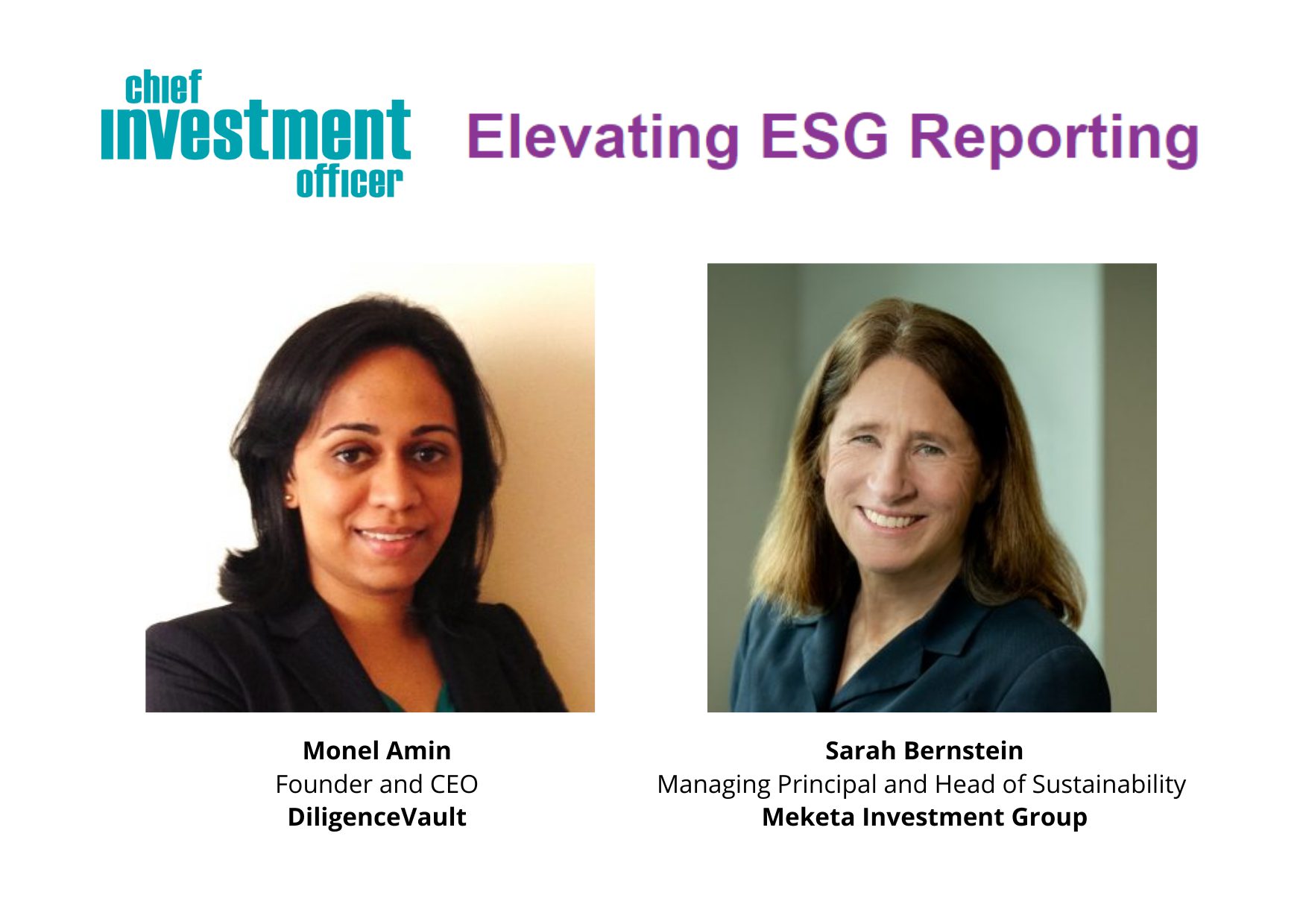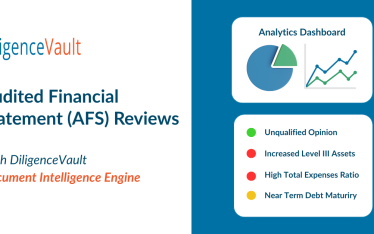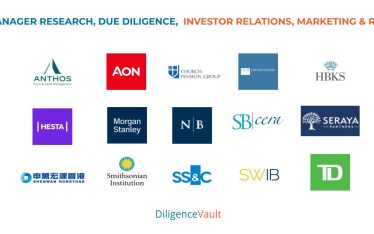Sustainable investing, which considers environmental, social and governance risks and opportunities, is growing exponentially. According to investment research and management firm Morningstar Inc., sustainable funds attracted record net inflows of nearly $70 billion in 2021, up 35% from the prior year. For asset owners and managers, this rapid growth presents new challenges to consistent ESG reporting, which is critical to making smart investment decisions. To find out how asset owners, asset managers and businesses are trying to meet these challenges, CIO spoke with Monel Amin, CEO of DiligenceVault, which offers a secure digital diligence platform for the investment management industry, and Sarah Bernstein, managing principal and head of sustainability for Meketa Investment Group, which advises more than 200 asset owners on approximately $1.8 trillion in assets.
CIO: Any investment strategy depends on ready access to reliable data. What’s the current state of reporting around ESG issues?

Monel Amin
Monel Amin: It’s chaotic, in large part because there is no consistent standard. There are a lot of reporting frameworks and standards, and new disclosure and reporting regulations across jurisdictions, but they’re not aligned. People also need more tools. Today, even if an asset owner or manager selects a framework, they often don’t have the technology needed to collect or process the information they get with a high degree of accuracy and consistency.
CIO: Why is collecting and processing data a challenge?
Amin: Three reasons. First, ESG information is not readily available in the public domain, especially for private companies. That means it has to be sourced directly from managers and businesses who often can’t measure all the requested data points. Second, asset owners and advisers historically have interacted with managers primarily through emails, phone calls and meetings. That doesn’t lend itself to systematic and consistent collection of information at the frequency needed to build a framework around ESG—and it’s definitely not scalable. Finally, there’s a limited amount of benchmarking information available.
CIO: What’s lost in this fragmented approach to ESG reporting?
Amin: Investors and asset managers are struggling with this new and complex reporting burden. They want a reporting framework with built-in accountability and KPIs that are consistent, periodic, high quality and able to be benchmarked. But we’re not there. ESG reporting remains resource intensive and often ambiguous.

Sarah Bernstein
Sarah Bernstein: The fragmented approach increases the time and resources that asset owners, managers and advisers spend trying to assess ESG risk factors—and may leave them with greater potential exposure to ESG risks and potentially lost investment opportunities.
CIO: What do asset owners want from managers in terms of ESG reporting?
Bernstein: It can vary. Some have little or no interest in ESG, but many want a comprehensive set of key ESG performance indicators, reported at least annually, to better understand risks and opportunities in their total portfolio and individual investment strategies relative to benchmarks. With some asset owners, we are seeing a rapid growth in demand for climate risk and opportunity data, particularly around carbon emissions, green revenues and renewables use and production—as well as information on diversity, equity and inclusion. Some asset owners want a core, limited set of ESG indicators—not 50 to 100 ESG metrics.
Amin: Our clients are requesting a lot of quantitative data around diversity and inclusion, not just at the general partner and management company level but through to the end investment. In terms of climate data, we are seeing a huge push for emission metrics. From a qualitative perspective, there is interest in governance control practices. With the recent Ukraine-Russia conflict, there also is renewed focus on sanctions, humanitarian issues and dependency on fossil fuel.
CIO: How are investment consultants trying to help?
Bernstein: Investment consultants are evolving their services to integrate material ESG factors throughout the consulting process, from consideration of investment beliefs and investment policy to asset allocation and public and private markets manager research. At Meketa, we are expanding the number of surveys we field and deepening their content. For example, we currently send managers a comprehensive DE&I survey. This year we also intend to send an ESG survey that’s more inclusive than in years past, with additional quantitative questions on climate and other factors.
CIO: What about asset managers? What are they doing?
Bernstein: Managers continue to increase their efforts to provide ESG data and information, with recent regulatory efforts expected to help standardize the core data requested across markets. On the private markets side, the ESG Data Convergence Project, launched in 2021, is trying to fill in where there are no regulatory standards. Its members have agreed not just on which general metrics to track but also on how to calculate them. Some managers are taking action on their own to better understand ESG risks and opportunities.
CIO: Is it only a lack of standards and systems holding back ESG reporting?
Bernstein: Time and resources are always an issue, especially for smaller companies. That said, the clearer the regulations are, and the more concise and material the metrics required, the easier it will be going forward to standardize reporting.
CIO: What excites you about the progress you’re seeing on ESG reporting?
Bernstein: The collaborative work going on across markets to help develop standardized information for investors holds great promise. In addition, I’m excited about the work of organizations like the International Sustainability Standards Board and the Global Reporting Initiative, as well as the Investment Consultants Sustainability Working Group–United States. The ICSWG-US is a collaboration among 17 investment consulting firms. It was established in 2021 to engage with its collective stakeholders and empower asset owners and their ultimate beneficiaries to advance sustainable investment practices across the investment industry. I’m also excited to see the progress over the years and the increase in data and tools available to help asset owners.
CIO: What are some next steps you’d like to see?
Amin: We’d like to see consolidation of ESG reporting standards to ensure ease of adoption. Failing that, the next natural step is mapping between the different standards to ensure reporting portability and reduce redundancy for asset managers. Today, a lot of effort is involved in developing a reporting process and ESG framework, but eventually the focus needs to shift to performance.
CIO: How is DiligenceVault trying to help?
Amin: A big challenge facing asset managers, whether they’re responding to inquiries directly or converting information from their portfolio companies, is that they don’t have a centralized hub for this information, or a robust control process. Our diligence platform is a technology that helps requesters of ESG information and the asset managers who supply it perform ESG reporting and analysis at scale, with consistency and historical, traceable data. We simplify a lot of the process and minimize the redundancy and effort required.
CIO: Can you give us an example?
Amin: Sure. Suppose an asset owner needs to collect data from their portfolio of 100 managers, and then build risk score reporting and sustainable development goals mapping based on that data. DiligenceVault’s technology automates this collection process via an online portal, provides transparency on the manager completion rates and creates a structured repository of these data points as opposed to wrangling 100 Excel files—all while enabling a consistent application of scoring and mapping to a sustainable development goals framework. Our platform also helps asset managers centrally track ESG reporting requests, see when they’ve answered a given set of questions before and reuse and repurpose that information.
CIO: What else can asset owners and managers do to move this field forward?
Bernstein: The evolution of regulatory and policy frameworks will be essential to improving ESG reporting. Asset owners and managers can help by commenting on proposed rules, like the SEC’s currently proposed climate disclosure rules. It’s important for the commission to hear from industry participants.

Note: for a PDF version of this article, please click here



